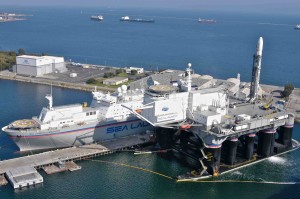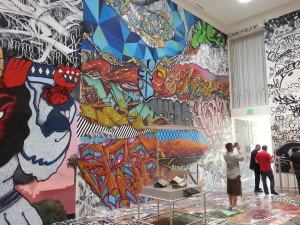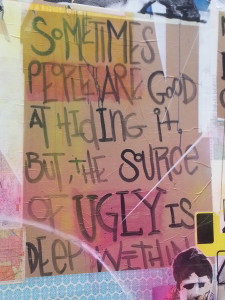LAX comings and goings in 2014 as only the mysterious SpeedbirdHD can do it.
Category Archives: South Bay
Sea Launch on hiatus

Sea Launch Commander (background) and Odyssey launch platform (foreground). Image courtesy Sea Launch
NYON, Switzerland, August 22, 2014 – Sea Launch announced today a series of cost-reduction measures designed to address an upcoming gap in the launch manifest of the Zenit-3SL system. According to plan, it is expected that Sea Launch will resume and start stepping-up its launch activity during mid-2015/mid-2016 time frame.
Before Hawthorne’s SpaceX grabbed the public’s imagination, the Sea Launch system took an audacious approach to launching satellites and made it happen in a few short years. The original consortium converted an offshore oil platform into a highly automated rocket launcher staffed and monitored from a mothership. Both travel to the equator and together lob communication satellites into geostationary transfer orbit. The earth spins fastest at zero latitude giving a free extra kick to the spacecraft. Since ‘geo’ is directly above the equator, it takes less rocket fuel to get the spacecraft where it needs to be. Once there, it can keep much more of its precious onboard fuel and last longer before replacement. Sea Launch has been in operation for many years with a large number of successes and a couple of failures. Its homeport is Long Beach. Drive into the port complex and go past Port V and you can see the mothership. The platform is most easily seen from the Gerald Desmond Bridge.
Following a launch failure a couple of years ago, the holding company went into bankruptcy, reorganized, and came back as a mostly Russian entity based in Switzerland. Space is a notoriously cold business and Sea Launch currently has no customers on its manifest. While it looks for some, it has decided to scale back, lay up the marine hardware, and reduce its staff. The press release says this is common in the sea business and that future customers are expected to turn up. Let’s hope so. Seeing launch hardware that exports products to space is a nice counterpoint to all the ships bringing products into the U.S. from other lands.
SCRATCH foretold
The 1978 Gary Weis Saturday Night Live film has been DMCAed out of existence but there is this which is also quite good. Toni Basil and The Lockers combine classic and modern:
SCRATCH continues at the El Segundo Museum of Art until 21 September 2014.
Odd Couples – SCRATCH at the El Segundo Museum of Art
I am not a big fan of rap. When I see graffiti in my neighborhood, I wonder what’s coming down the pike. I’ve never seen anyone improved by a tattoo. But, there is no doubt that there are some major creative talents working in all of those forms and that their connection to traditional, accepted art is more than tenuous.
rap. When I see graffiti in my neighborhood, I wonder what’s coming down the pike. I’ve never seen anyone improved by a tattoo. But, there is no doubt that there are some major creative talents working in all of those forms and that their connection to traditional, accepted art is more than tenuous.
Graffiti and medieval manuscripts aren’t obvious partners but can go together like peanut butter and chocolate. Context, it seems, matters. LA’s Antics Performance Group continues to develop “Illuminated Manuscript” presented almost exactly a year ago at the Ford Amphitheatre. Amy “Catfox” Campion staged the Gilgamesh epic with an ensemble of fearless dancers to a pulsing score. Each scene is set to a video clip of a tagger doing his or her thing, illuminating the manuscript or stone tablet as the case may be. It was absorbing, thrilling, and falling short of epic by being just a little too short.
This year the Getty Research Institute and collector Ed Sweeney present SCRATCH a purely visual pairing along very similar lines at the El Segundo Museum of Art. Sweeney saw a connection, the Getty’s David Brafman agreed. ESMoA is art’s analog of a black box theater: A single long room with a vaulted ceiling, it’s success depends on the ambitions of the exhibits and here it succeeds in spades. The walls and floors are decorated by graffiti and tattoo artists from the greater Southern California area. It is an in-yer-face riot of color and literally larger-than-life representations. Some are by individuals, others by the artists working in groups. That, in itself, is surprising. We hear much of the individual, highly competitive world of graffiti. The artists acknowledge one another but to hear of them collaborating like this is like hearing of an anarchist collective. The creative choreography at work here must be an interesting story in and of itself. However it was done, it was done – much like Campion pulled together her Gilgamesh ensemble from several disciplines within the modern dance community.
The connection among the modern artists and the medieval manuscript is the Liber Amicorum or Book of Friends. We learn that it is customary for graffitists to contribute to one another’s sketchbooks as had been done in centuries past by artists of a different stripe. There are many sober display cases containing the Getty’s contribution of antiquaria, printed and scribed, for easy comparison. The older works are definitely of the subtle, understated type where the modern are emphatically not. Subject matter aside, there are some intriguing similarities in shading and the creation of depth in a two dimensional medium. The logistical problems would be many but a performance of Illuminated Manuscript would go well with this exhibit.
 Technology unobtrusively supports the art. There are iPads aplenty, photography without flash is allowed. The Getty has taken a lead in digitizing rare materials and one can easily flip through page after page of images of the priceless books in the cases. A large chunk of it is online and can be examined from home. Johann Michael Püchler’s Calendarium Perpetuum is an almost infinitely-recursive exploration of his world and time. What look like lines and hatches are actually words upon magnification. It’s also an engraving meaning he did this with a stylus and in mirror-image.
Technology unobtrusively supports the art. There are iPads aplenty, photography without flash is allowed. The Getty has taken a lead in digitizing rare materials and one can easily flip through page after page of images of the priceless books in the cases. A large chunk of it is online and can be examined from home. Johann Michael Püchler’s Calendarium Perpetuum is an almost infinitely-recursive exploration of his world and time. What look like lines and hatches are actually words upon magnification. It’s also an engraving meaning he did this with a stylus and in mirror-image.
There are plenty of other good reasons to go see SCRATCH. The LA Times is an unqualified disaster when it comes to theater and classical music reporting but has not yet given up the ghost when it comes to art commentary. New addition Carolina Miranda provides some background in a blog post. One delightful bit of fallout from this melange is that it has nicely honked off a segment of the right wing.
El Segundo has quietly become a destination. Between the chemical industry on one side and aerospace on the other lie a growing collection of breweries, galleries, shops, restaurants, the Old Town Music Hall, and a clean, well-lit 99-cent store.
The Making of video: No sound – Wish I’d stopped by the museum as this was happening…
LAX planespotting from and on a different level – SpeedbirdHD
The small and very active community of aircraft photographers and videographers is putting up some superb material on the usual outlets. Close to home, many shoot from El Segundo’s Clutter Park where they can get nice views of LAX’s south runway operations although with some interference from low buildings.
Then, there is Youtube’s SpeedbirdHD. He says little about himself other than that he is an aviation enthusiast in Los Angeles. There must be more to it than that. He has unique access to LAX operations, almost assuredly through a job on the premises. His videos of the heavy metal flying in and out are in a league of their own. Speedbird and his HD camera get tarmac footage of regional jets, superjumbos, and even the occasional miltary lifter from every runway. His edits usually include relevant air-traffic control conversations in the background. Top class stuff.
Here’s his channel. His 2012 highlight reel is a good place to start.
Real-time LAX air traffic tool – a must-have for South Bay residents
Instrumentation makers Bruel and Kjaer are working with many airports to measure and display sound levels in the neighborhoods they adjoin. B&K’s Webtrak tool for LAX is available at http://ems02.bksv.com/webtrak/lax4
See flights coming in and out of the greater Los Angeles area in real time. See sound levels in Playa del Rey, Hawthorne, El Segundo, and Inglewood. There’s also a replay feature. Use Historical Mode to pick a day and time and see what happened; speed it up if you like. If you’d like to complain about a particular flight, select the icon of the suspected flight, get its number, and click a link to file a report.
The Beach Cities are usually quiet despite LAX but there are many nights where the engine roar is powerful despite distance and intervening structures. So, what can cause this? Thermal inversion layers in the atmosphere are known to refract sound waves due to the index of refraction difference at the boundary. Acoustical engineer Mike O’Connor offers a nice summary of the physics, analogous to optical refraction, at http://www.mocpa.com/inversion.html
He concludes
“It is not only noise from vehicular traffic on distant segments of roadways that is boosted in strength by temperature inversions. Emissions from distant trains and commercial aircraft (during takeoffs) are also amplified. The reader who has never before taken note of this phenomenon might now try to see if it’s ‘real’. Just listen to the background noises from distant trains, distant aircraft (just during takeoff runs) and vehicles on distant roadway segments, preferably after dark or shortly before or after dawn, and note the atmospheric conditions. Disregard windy conditions, but take note of the loudness of such noises under all other atmospheric conditions. It should become apparent that the noise levels from distant sources are clearly higher on some days than on others, even though the observations were made at approximately the same time each day. With some effort it should also be apparent that the calm and clear conditions that are said here to give rise to temperature inversions are in effect when the distant sources seem loudest.”
Henry Robinson offers a more detailed treatment at http://www.lochlyn.org/atmophys/sound/sound.pdf with an interesting observation about amphitheatre design.
“On a day when convection near the ground causes the temperature to decrease rapidly with height, sound heard on the ground from a departing aircraft will be muffled because the sound rays, and energy, will be forcing the sound upward. Indeed, balloonists often can hear conversations of people on the ground but be unable to make themselves heard by the same people on the ground. The Greeks constructed their theaters, as in Figure 3, so everyone could see, but, in doing so, they also used the natural curvature of sound to enable everyone to hear as well in afternoon plays.
Takeoff during well mixed conditions is relatively quiet at the ground but takeoff through an inversion concentrates the sound under the aircraft. Observe sound abatement procedures while taking off in an inversion situation.”
So, is that the mechanism at work on noisy Redondo Beach nights? This is worth some observation and checking against weather data.